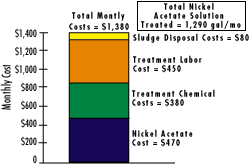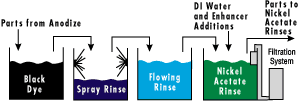Extending Finishing Bath Life
How Astroplate extended bath life using filtration and other techniques...
Spent process baths can be a significant and expensive waste stream for finishing facilities. Numerous factors can degrade bath performance, including depletion or imbalance of bath chemistries and buildup of contaminants from dragin or other sources. When a bath is spent, it is typically batch treated on site, bled into an on-site wastewater treatment system or put in a container for off-site treatment and disposal. Frequent bath dumps lead to excessive chemical use, increased treatment chemical use and labor requirements as well as greater sludge generation.
Process bath life can be extended through simple process control and contaminant reduction techniques, resulting in significant waste reductions and cost savings. The case study presented here describes techniques that extended the life of a nickel-acetate seal bath at Astroplate in Phoenix, AZ. The concepts, however, are applicable to a variety of process baths.
Astroplate is a small finishing facility that performs sulfuric acid anodizing and chromate conversion on aluminum parts for the aerospace and industrial industries. Astroplate employs 23, runs two shifts per day and uses a manually operated hoist to move parts on racks through process steps.
Anodizing process operations include alkaline cleaning, alkaline etching, acid cleaning, deoxidizing, anodizing, dyeing and sealing. Anodizing forms a porous oxide coating on the part, which provides wear and scratch resistance, corrosion protection and a decorative texture, color and appearance.
Sealing is the final step in the anodizing process. It improves the corrosion resistance of anodized surfaces by penetrating and closing the pores of the oxide layer. A good seal is clean and clear. A poor seal may leave a fine film (smut) or yellow tint on the part.
Before sealing, color is often added by impregnating the pores with dyes or mineral pigments. Nickel-acetate solution is the most commonly used seal for dyed anodic coatings because of its ability to retain the color of the dye.
Tetra Tech EM Inc., San Francisco, CA, which provided technical support, performed a P2 assessment at Astroplate and identified spent nickel-acetate solution as a frequently generated and costly waste. Astroplate operates a single, 560-gal nickel-acetate seal bath. Nickel-acetate sealing follows dye operations (primarily black dye) and is the final process step on Astroplate's anodizing line.
Astroplate dumps the nickel-acetate bath as soon as smut forms on sealed parts. On-site batch treatment records indicated that the nickel-acetate bath was dumped an average of 2.3 times per month. This generated about 1,290 gal of spent acetate solution. Because spent nickel-acetate baths were treated more often than other process baths, they accounted for a significant portion of the facility's wastewater treatment costs and sludge generation. Each month, Astroplate spent approximately $470 for process chemicals; $380 for treatment chemicals, $450 (nine hours) for labor and $80 (150 lbs) on sludge generated from treating spent nickel-acetate baths.
Based on an evaluation of facility process operations, Tetra Tech and Astroplate determined that frequent nickel-acetate bath dumps were the result of inadequate process control and dragin from preceding process operations. Consequently, the strategy for extending nickel-acetate bath life focused on maintaining process control, decreasing bath contamination and using a bath additive.
Maintaining process bath control
Operating parameters that may affect bath performance include concentration, pH and temperature. Astroplate uses Anoseal 1000 as the nickel-acetate bath chemical. During the P2 assessment, Astroplate performed nickel-acetate bath dumps based on visual observation of sealed parts. It did not measure any bath parameters and did not make any chemical additions to the bath.
Following the P2 assessment, Astroplate monitored and recorded the concentration, pH and temperature of the nickel-acetate bath. Initially, Astroplate maintained these parameters within the chemical manufacturer's recommended ranges, but the facility eventually determined the best operating parameters for its own process applications. Astroplate maintained the bath concentration at 1.5 to 2.5% nickel acetate by making chemical additions as needed. Astroplate determined that maintaining the concentration in this range resulted in acceptable seal quality while reducing nickel acetate use.
Astroplate maintained the bath pH between 5.8 and 6.0 using acetic acid to lower pH and dilute ammonium hydroxide to raise it. Astroplate also maintained the bath temperature at 155 to 165F. The facility operated the bath below the temperature range recommended by the chemical manufacturer to reduce evaporative water loss and minimize part heating, which reduced streaking and spotting.
Decreasing bath contamination
During the P2 assessment, Astroplate's nickel-acetate bath was contaminated by black-dye dragin and city water used for bath makeup and additions. To decrease bath contamination, Astroplate installed a continuous filtration system on the nickel-acetate bath, used DI water to make up the new nickel-acetate bath and modified the rinse system on the preceding black-dye operation to include spray rinses.
Filtration
Filtration removed suspended solids that could gradually build up and impair the nickel-acetate seal. A filtration system also circulated the process solution to help maintain a uniform bath temperature and concentration. Filtration systems were sized according to solids loading and flow rate. Astroplate installed an external filtration system from Serfilco, Ltd., on the nickel-acetate bath. The filtration system housing held six cartridge filters. A centrifugal pump continuously circulated solution through the system. To prevent pump damage when the cartridges became fully loaded, Astroplate installed a pressure-sensitive, automatic shut-off switch on the filtration system. Twenty-micron cartridge filters in the system were replaced about once a week. Spent filters were cleaned in an acid strip bath and disposed of properly.
DI water
Originally, Astroplate used city water to make up new nickel-acetate baths. However, using DI water for bath makeup minimized contamination. For example, laboratory analysis indicated that tap water in Phoenix had an average concentration of 14 mg/liter of silicate, a compound that can decrease nickel-acetate bath life. After the P2 assessment, Astroplate installed a DI water system from Pure Rain Technologies. About 420 gallons of DI water were used to make up each new bath. In addition, DI water was added to the bath to make up for evaporative losses.
Spray rinses
Process chemical dragin was a major source of nickel-acetate bath contamination. The P2 assessment determined that dragin could be reduced by improving preceding rinse operations. Originally, after anodizing, parts were processed in the black-dye tank and rinsed in a single, flowing rinse before sealing. Although the rinse water flow rate was 3.6 gpm, black dye was dragged in at a rate high enough to discolor the nickel-acetate bath and give it a gray tint. Following P2 assessment, Astroplate added a spray rinse tank before the black-dye flowing rinse to reduce black-dye dragin.
The spray rinse also allowed Astroplate to collect concentrated black-dye rinse water and return it to the black-dye bath, reducing chemical use. It also allowed the company to operate the flowing rinse at a lower flow rate, which reduced water and sewer fees.
Spray system components included recessed nozzles, check valves to maintain water pressure in the pipes connected to the nozzles so that the spray pattern developed quickly when the system was turned on and a foot pedal activated the system.
Using a bath additive
Additives were available for some process baths to replenish lost chemicals and introduce chemical agents to boost bath performance. After the P2 assessment at the facility, an additive was identified that was specifically designed to prolong the life of nickel-acetate seal baths. The additive added wetting and dispersing agents to improve seal quality and prevent smut and white powder formation on parts. The additive also produces a hydrophobic anodic coating that helps water run off parts, minimizing water spotting. Astroplate added an average of 1.3 gal of this additive to the nickel-acetate bath weekly. The exact amount in a given week depended on the observed seal quality.
Costs
The capital and operation and maintenance costs for the modifications were representative implementation costs for the P2 techniques used by Astroplate, except for the cost of the spray-system tank liner. Astroplate needed the tank liner to reinforce an old plastic tank used for the spray rinse. Therefore, the total cost for the spray system was probably a bit higher than for a typical system.
Results. Before implementing bath-life extension techniques, Astroplate dumped its nickel-acetate bath an average of 2.3 times per month, resulting in a 1,290-gal spent nickel-acetate waste stream. Bath-life extension techniques were implemented first because of their low capital costs and ease of implementation. The Phase 1 efforts decreased the average bath dump frequency to 1.5 dumps per month.
Phase 2 involved the filtration system, DI water and black-dye spray rinse system. These techniques required more time to implement because they involved equipment selection, purchase and installation. After Phase 2 implementation, the average bath dump frequency decreased to 0.6 dump per month. The total amount of spent nickel-acetate solution generated each month decreased by 950 gal to an average of 340 gal.
Because of the Phase 1 and 2 efforts, generation of spent nickel-acetate solution decreased by 74%. During Phase 1 and 2, no major changes in facility production levels occurred. The decrease in nickel-acetate chemical use, treatment chemical use, treatment labor and sludge disposal resulted in an annual cost saving of $12,130. The environmental benefit is a decrease of 56 lbs/year of nickel released in treatment sludge or discharged in wastewater.
The company will realize additional cost savings through return of black-dye spray rinse water to the black-dye bath and reduced rinse water use in the dye's flowing rinse. The cost to make up the 550-gal black-dye bath is $930. Astroplate can reduce its black dye purchase costs by as much as $150/month by returning the spray rinse water to the process bath.
Related Content
Products Finishing Reveals 2024 Qualifying Top Shops
PF reveals the qualifying shops in its annual Top Shops Benchmarking Survey — a program designed to offer shops insights into their overall performance in the industry.
Read MoreTroubleshooting Alkaline Zinc
One of the most common problems that can arise when plating with alkaline zinc is an imbalance of brightener in the solution. In this helpful Ask the Expert article, Chad Murphy of Columbia Chemical discusses how different zinc metal concentrations and brightener concentrations can impact efficiency.
Read MoreAn Overview of Electroless Nickel Plating
By definition, electroless plating is metal deposition by a controlled chemical reaction.
Read More3 Tests to Ensure Parts are Clean Prior to Plating
Making sure that all of the pre-processing fluids are removed prior to plating is not as simple as it seems. Rich Held of Haviland Products outlines three tests that can help verify that your parts are clean.
Read MoreRead Next
Education Bringing Cleaning to Machining
Debuting new speakers and cleaning technology content during this half-day workshop co-located with IMTS 2024.
Read MoreA ‘Clean’ Agenda Offers Unique Presentations in Chicago
The 2024 Parts Cleaning Conference, co-located with the International Manufacturing Technology Show, includes presentations by several speakers who are new to the conference and topics that have not been covered in past editions of this event.
Read MoreDelivering Increased Benefits to Greenhouse Films
Baystar's Borstar technology is helping customers deliver better, more reliable production methods to greenhouse agriculture.
Read More














.jpg;maxWidth=300;quality=90)









